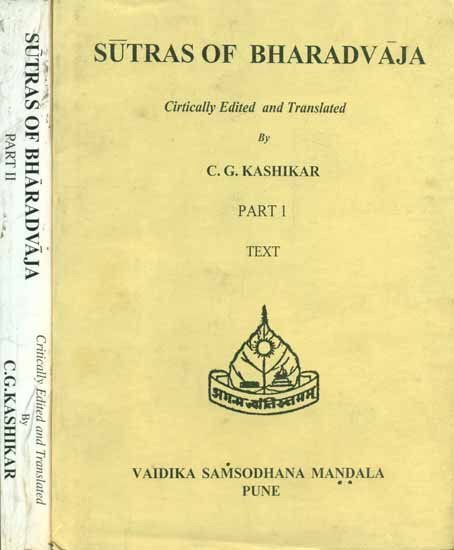Bharadvaja-srauta-sutra
by C. G. Kashikar | 1964 | 166,530 words
The English translation of the Bharadvaja-Srauta-Sutra, representing some of the oldest texts on Hindu rituals and rites of passages, dating to at least the 1st millennium BCE. The term Srautasutra refers to a class of Sanskrit Sutra literature dealing with ceremonies based on the Brahmana divisions of the Veda (Sruti). They include Vedic rituals r...
Praśna 14, Kaṇḍikā 8
1. We shall now explain the third pressing.
2. While many people are within the Mahāvedi,[1] the Adhvaryu should draw the Āditya cup.
3. If an enemy of the sacrificer is performing a Soma-sacrifice, the sacrificer should remain outside his Mahāvedi until the Āditya cup is drawn.
4. If an enemy, among others, has entered the Mahāvedi, the Adhvaryu should draw the Āditya cup while he is still within the Mahāvedi.
5. After having closed the doors of the Havirdhāna, the Adhvaryu should draw into the Āditya cup Soma from the Āditya vessel (so as to render it) one-third portion (of the Āditya cup). (He should take up three portions[2] into the Āditya cup) respectively with the three verses,“O Indra, thou art never barren; never dost thou fail thy worshipper. Now more and more is thy divine gift increased, O bountiful one. Thou art taken with a support; for the Ādityas thee.—At no time art thou heedless, but dost guard the two generations. The pressing is thy strength, O fourth Āditya. The ambrosia is ready in the heaven. Thou art taken with a support; fcr Ādityas thee.—The sacrificer seeks the favour of the gods, be you kindly, O Āditya. May your favour come hither that it may the more free us from affliction. Thou art taken with a support; for Ādityas thee.”[3]
6. He should take up Soma as the first portion, curdled hot milk[4] as the second portion and again Soma as the third portion. He should draw curdled milk in the middle with the Triṣṭubh verse. So is it said.
7. For one desirous of rains, he should add the curds at last with the formula, “I mix thee with what is heavenly rain.”[5] (In this case) he should not draw the curdled milk in the middle.
8. After having left in its place the Āditya vessel with remnants of Soma, he should put down the Upāṃśusavana pressing stone into the cup with the formula, “O bright Āditya, this is thy Soma-drink; delight in it, be satiated with it; may we who satiate thee be satiated.”[6]
9. After having lifted it up, he should make the prediction: if a drop falls down immediately, rain will fall; if late, rain will not fall.
10. Without placing down, the Adhvaryu should take the cup and stand with the formula, “May god Sūrya protect me from the gods; Vāyu from the midregion. May Agni, the sacrificer, protect me from the evil eye. O strong one, O impetuous one, O instigator, O thou of all men, with these names, O Soma, we shall worship thee; with these names, O Soma, we shall worship thee.”[7]
11. Then he should give out the call (to the Maitrāvaruṇa),“Do you recite the puronuvākyā relating to the offering for the Adityas, the beloved having a lovely abode, whom the ordinances are dear, the guardians of big home, the lords of wide midregion.”
Footnotes and references:
[3]:
Taittirīya-saṃhitā I.4.22.
[4]:
XII.21.8.
[5]:
Taittirīya-saṃhitā I.4.22.
[6]:
Taittirīya-saṃhitā I.4.22.
[7]:
Taittirīya-saṃhitā III.5.5.1.
